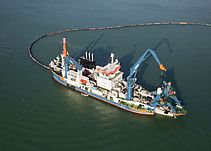Mixing in a dredge cutter head
Bas Nieuwboer
Cutter suction dredgers are used to dredge sand, clay and rock in relative shallow water for creating harbours or entrance channels. The material is cut by a rotating cutter head with pickpoints attached. These pickpoints cut the rock. The blades at which these pickpoints are attached guide the pieces of rock into the cutter head. Via a suction mouth the rock is then sucked up to the dredging vessel.

A cutter suction dredger

Cutter head
When cutting rock, current cutter heads can spill up to 50% of the cut material. This spillage can be defined as the amount of rock that is cut, but is not sucked up through the suction mouth. Spillage is caused by the cutting process and by the mixing process of cut rock with water in the rotating cutter head. The pickpoints at the blades of the cutter head chisel away the rock, the pieces of rock can either enter the cutter head or be pushed away from the cutter head. When they are pushed away the rock is considered spilled due to the cutting process. After the rock enters the cutter head and it is thrown out again, it is considered spillage due to the mixing process. This research focusses on the second kind of spillage.The goal of this research is to describe the mixture processes of cut rock in a dredge cutter head. The importance of different processes in the cutter head will be assessed using both a numerical model and performing model tests.
For the modelling purpose a finite volume package OpenFOAM is used. The rock will be modelled using a Discrete Element Method (DEM). These are finite size particles which interact with the flow and with each other. For validation purposes also model test will be performed.
The knowledge obtained from this research can be used in the future to improve the design of rock cutter heads with respect to the spillage.
This research is financially supported by Royal Boskalis Westminster Dredging BV and Van Oord Dredging and Marine Contractors.